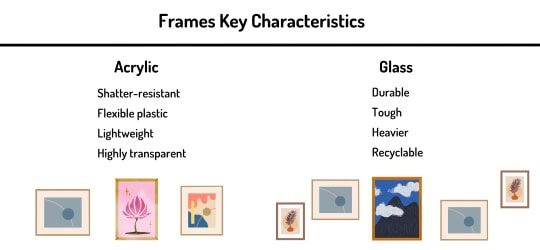Acrylic vs. Glass – which is better for picture frames?
If you’re looking to hang artwork or pictures, then you might have found yourself at a crossroads with choosing between glass and acrylic picture frames.
To understand the use case of each, the pros and cons, and which material you should be choosing, we’ve put together this simple guide to help you weigh up the decision.
What is Acrylic?
A bit of housekeeping before we jump into Acrylic vs. Glass for picture frames.
What exactly is Acrylic and why is it a popular choice in framing?
Acrylic or Plexiglass as it is sometimes known is a shatter-resistant, flexible plastic material that is far less likely to break than glass. Just like glass, acrylic is completely transparent and offers the same protective qualities as glass, however, it is significantly lighter and easier to transport than its class counterpart.

Pros of Acrylic for Picture Frames
- Acrylic is more resistant to sudden impacts than glass. Where glass is likely to shatter, acrylic is far more likely to ‘absorb’ the impact without causing damage to the frame or the artwork.
- Believe it or not, acrylic is actually even more transparent than glass which means that it can display artwork in true colours without any tint that may occur in glass.
- Despite being less recyclable, Acrylic is actually easier to produce and requires significantly less resources to produce which makes it ideal in single-use purchase applications such as frames which are intended to be kept and maintained for years to come.
- Acrylic does not shatter when broken. Perhaps one of the most appealing aspects for families and for commercial applications, Acrylic is a far safer option than glass because it will not shatter.
- Acrylic is highly resistant to condensation which makes it an ideal choice in humid environments where moisture can otherwise become an issue.
Pros of Glass for Picture Frames
- Glass is generally ‘tougher’ than acrylic which makes it more difficult to scratch and therefore less prone to signs of wear – particularly when subject to impact or moving.
- Glass is less likely to degrade over time and is an ideal choice for its longevity alone.
- Glass is, by definition, easier to recycle and is a slightly greener choice than acrylic which is much more difficult to recycle.
Cons of Acrylic for Picture Frames
- Acrylic is easier to scratch and, once that scratch appears, is almost impossible to fix – particularly when you know where it is.
- Acrylic is difficult to recycle and is classified as plastic waste which means that it is a less ‘green’ choice than glass in short-term applications.
- Acrylic can be tricky to clean. Get it wrong and you can scratch the surface which can be almost impossible to fix.
- Acrylic is prone to warping in extreme conditions such as sudden changes to heat or humidity.

Cons of Glass for Picture Frames
- Glass can shatter if dropped or struck with a high impact object. In residential applications, glass may be less safe for those with children.
- Glass can be extremely heavy which means that extra caution needs to be taken when moving or hanging artwork.
- If glass shatters, it can also damage the artwork.
- Glass can be prone to condensation which can cause moisture damage to the artwork when displayed in a humid environment over an extended period of time.
Acrylic vs. Glass – Which is Better for Picture Frames
Now that we know the pros and cons – which is better for picture frames, glass or acrylic? Well, as you will have seen above, the answer isn’t that straight forward. It comes down to a number of factors including cost, intended use, environment, and how you intend to display your artwork. Other important factors to consider when choosing between glass and acrylic include:
- Environmental conditions
- Location of the artwork
- Sunlight and UV exposure
- Size of the artwork
- Cost and budget considerations
- Where you intend to hang the artwork
When it comes to choosing between glass and acrylic, traditionalists will almost always opt for glass. However, if you’re looking for a ‘lighter’ option than is safe for commercial and residential applications, acrylic makes a very strong case for itself and is fast becoming a popular alternative.
